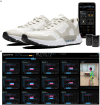Gait analysis using digital biomarkers including smart shoes in lumbar spinal canal stenosis: a scoping review
- PMID: 38162877
- PMCID: PMC10757616
- DOI: 10.3389/fmed.2023.1302136
Gait analysis using digital biomarkers including smart shoes in lumbar spinal canal stenosis: a scoping review
Abstract
Lumbar spinal canal stenosis (LSS) is characterized by gait abnormalities, and objective quantitative gait analysis is useful for diagnosis and treatment. This review aimed to provide a review of objective quantitative gait analysis in LSS and note the current status and potential of smart shoes in diagnosing and treating LSS. The characteristics of gait deterioration in LSS include decreased gait velocity and asymmetry due to neuropathy (muscle weakness and pain) in the lower extremities. Previous laboratory objective and quantitative gait analyses mainly comprised marker-based three-dimensional motion analysis and ground reaction force. However, workforce, time, and costs pose some challenges. Recent developments in wearable sensor technology and markerless motion analysis systems have made gait analysis faster, easier, and less expensive outside the laboratory. Smart shoes can provide more accurate gait information than other wearable sensors. As only a few reports exist on gait disorders in patients with LSS, future studies should focus on the accuracy and cost-effectiveness of gait analysis using smart shoes.
Keywords: digital biomarker; gait analysis; lumbar spinal canal stenosis; smart shoes; wearable sensor.
Copyright © 2023 Morimoto, Hirata, Kobayashi, Tsukamoto, Yoshihara, Toda and Mawatari.
Conflict of interest statement
The authors declare that the research was conducted in the absence of any commercial or financial relationships that could be construed as a potential conflict of interest.
Figures



Similar articles
-
Identifying predictors for postoperative clinical outcome in lumbar spinal stenosis patients using smart-shoe technology.J Neuroeng Rehabil. 2017 Jul 18;14(1):77. doi: 10.1186/s12984-017-0288-0. J Neuroeng Rehabil. 2017. PMID: 28720144 Free PMC article.
-
Objectively quantifying walking ability in degenerative spinal disorder patients using sensor equipped smart shoes.Med Eng Phys. 2016 May;38(5):442-9. doi: 10.1016/j.medengphy.2016.02.004. Epub 2016 Mar 9. Med Eng Phys. 2016. PMID: 26970892 Free PMC article.
-
Objectifying clinical gait assessment: using a single-point wearable sensor to quantify the spatiotemporal gait metrics of people with lumbar spinal stenosis.J Spine Surg. 2021 Sep;7(3):254-268. doi: 10.21037/jss-21-16. J Spine Surg. 2021. PMID: 34734130 Free PMC article.
-
The role of wearable devices and objective gait analysis for the assessment and monitoring of patients with lumbar spinal stenosis: systematic review.BMC Musculoskelet Disord. 2019 Jun 15;20(1):288. doi: 10.1186/s12891-019-2663-4. BMC Musculoskelet Disord. 2019. PMID: 31202276 Free PMC article.
-
Analysing gait patterns in degenerative lumbar spine diseases: a literature review.J Spine Surg. 2022 Mar;8(1):139-148. doi: 10.21037/jss-21-91. J Spine Surg. 2022. PMID: 35441102 Free PMC article. Review.
Cited by
-
Influence of decompression by laminotomy and percutaneous tansforaminal endoscopic surgery on postoperative wound healing, pain intensity, and lumbar function in elderly patients with lumbar spinal stenosis.Ann Med. 2025 Dec;57(1):2472865. doi: 10.1080/07853890.2025.2472865. Epub 2025 Mar 3. Ann Med. 2025. PMID: 40033779 Free PMC article.
References
-
- GBD 2015 Disease and Injury Incidence and Prevalence Collaborators . Global, regional, and national incidence, prevalence, and years lived with disability for 310 diseases and injuries, 1990-2015: a systematic analysis for the global burden of disease study 2015. Lancet. (2016) 388:1545–602. doi: 10.1016/s0140-6736(16)31678-6, PMID: - DOI - PMC - PubMed
Publication types
LinkOut - more resources
Full Text Sources
Research Materials

